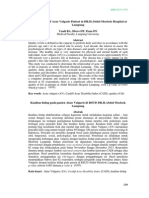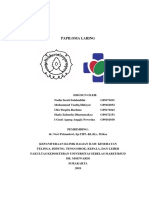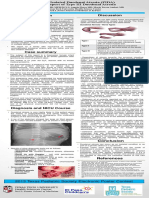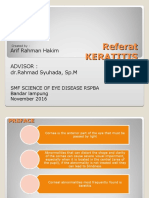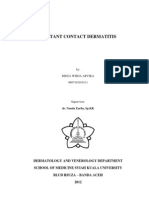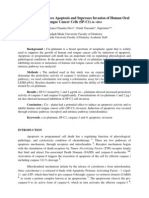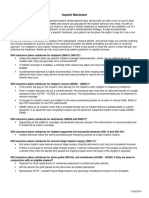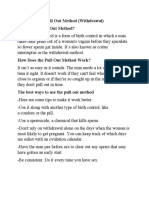Erosive Lichen Planus of The Oral Cavity: A Case
Erosive Lichen Planus of The Oral Cavity: A Case
Uploaded by
Fuad HasanCopyright:
Available Formats
Erosive Lichen Planus of The Oral Cavity: A Case
Erosive Lichen Planus of The Oral Cavity: A Case
Uploaded by
Fuad HasanOriginal Description:
Original Title
Copyright
Available Formats
Share this document
Did you find this document useful?
Is this content inappropriate?
Copyright:
Available Formats
Erosive Lichen Planus of The Oral Cavity: A Case
Erosive Lichen Planus of The Oral Cavity: A Case
Uploaded by
Fuad HasanCopyright:
Available Formats
DOI: 10.
17354/SUR/2015/27
Case Report
Erosive Lichen Planus of the Oral Cavity: A Case
Report
P Rajesh Raj1, Nadah Najeeb Rawther1, Jittin James2, KP Siyad3, Sheeba Padiyath4
1
Post Graduate Student, Department of Oral Medicine and Radiology, Mar Baselios Dental College, Kerala, India, 2Senior
Lecturer, Department of Prosthodontics, Mar Baselios Dental College, Kerala, India, 3Senior Lecturer, Department of
Periodontics, Indira Gandhi Dental College, Kerala, India, 4Reader, Department of Oral Medicine and Radiology, Mar
Baselios Dental College, Kerala, India
Abstract
Erosive lichen planus (LP) is a clinical form of oral LP characterized by the bilateral presentation of erosive and erythematous
areas in the oral cavity usually the buccal mucosa with predominance in middle aged females with undue stress factors. In this
article, we are giving a case report of a 56-year-old female patient who came to our Department of Oral Medicine and Radiology
with a chief complaint of burning sensation of the mouth to hot and spicy food. The diagnosis was given as erosive LP. We also
aim to review the literature and management of the lesion with reference to the same.
Keywords: Burning sensation, Erosive lichen planus, Oral lichen planus, Topical steroids, Wickhams striae
INTRODUCTION Here we are also presenting a case report of an erosive
type of LP where the patient was symptomatic. She was
O ral lichen planus (OLP) derived from the Greek
word Leichen meaning tree moss and Latin
word planus meaning flat/even. It was first described
also undergoing a stressful phase of her life. When she
was given a topical and systemic steroid combination
along with psychiatric counseling active lesions
in 1869 by Dr. Erasmus Wilsonas.1 This is a common stopped occurring when she was being reviewed after
immune-mediated disorder that affects stratified 6 months.
squamous epithelium and is of unknown etiology. It is
seen worldwide, mostly in the fifth to sixth decades of CASE REPORT
life,2 frequently in the middle aged and occasionally in
children. This lesion is twice more common in women than The 56-year-old female patient came to the Department
in men with a bilateral presentation.3 It is often a painful of Oral Medicine and Radiology with a chief complaint
and debilitating disease, and the treatment is aimed at of burning sensation of the entire oral cavity to hot and
palliation rather than cure.4 In such lesions, corticosteroids spicy foods. Burning sensation started almost 2 months
are considered to be the mainstay of treatment which can back which was insidious in nature and aggravated on
be used either topically, intralesionally or systematically. having spicy food. Presently, she complained of difficulty
in having even soft foods. Dental history showed that
Weyl in 1885 initially described the characteristic surface she has had uneventful extractions. Her medical history
markings on LP papules,4 and Louis Frederic Wickham revealed that she was a victim of hypertension and
in1895 termed it as Wickhams striae.5 hyperlipidemia and is under medications. Personal history
showed that she had a mixed diet and was presently under
Access this article online stress and tension.
Month of Submission : 06-2015 On intraoral examination, there were erythematous
Month of Peer Review : 07-2015 areas with scattered, irregular white keratotic flecks
Month of Acceptance : 07-2015 on the right and left buccal mucosa. On the left side,
Month of Publishing : 08-2015 the lesion was about 1.5 cm 1 cm situated along the
www.surgeryijss.com
premolar and molar regions, respectively (Figure 1).
Corresponding Author: Dr. Nadah Najeeb Rawther, Department of Oral Medicine and Radiology, Mar Baselios Dental College, Kerala,
India. Phone: +91-9746122926. E-mail: nadahsiyad85@gmail.com
24 IJSS Journal of Surgery | Jul-Aug 2015 | Volume 1 | Issue 4
Raj, et al.: Erosive Lichen Planus of the Oral Cavity
On the right side, the lesion was about 2.5 cm 1 cm DISCUSSION
situated along the third molar region (Figure 2).
Adjacent mucosa appeared normal. On palpation all OLP is a common chronic inflammatory and immunological
inspection findings were confirmed and the lesion was mucocutaneous disorder1 that varies in appearance from
non-tender. keratotic (reticular or plaque like) to erythematous and
ulcerative clinical forms.2 In the year 1869, it was Erasmus
The patient was advised for biopsy and was subjected Wilson who first named the skin lesion. In 1895, Thieberg
to routine blood investigations. Fasting blood sugar was identified the oral lesion.5
found to be 92 mg/dl.
1-2% of the population worldwide suffers from OLP.
1.5-2% of the Indian population suffers from this disease.
During her treatment period, she was given topical
Female predilection was found with a male to female ratio
steroids along with systemic steroids. Initially, she was
of 1:2 especially among the middle aged.6,7 In our case,
being reviewed at an interval of every 1-2 weeks for the patient was in her fifth decade of life.
6 months. When active lesions had stopped forming, the
doses of the medications were being tapered and she was The different etiological factors considered for
being reviewed after every 6 months period. LP are genetic background, drugs, autoimmunity,
immunodeficiency, stress, diabetes, hypertension,
When the patient was reviewed at the end of 6 months, malignant neoplasm, and bowel disease.8 The various
the lesions had completely resolved, and the patient had koebnerogenic factors are dental materials, an infectious
a better outlook to life (Figures 3 and 4). agent such as human papillomavirus, food allergy, habits
Figure 1: Erosive and erythematous lesions on the left buccal Figure 3: Healed areas on the left buccal mucosa after 6
mucosa months
Figure 2: Erosive areas on the right buccal mucosa Figure 4: Healed areas of the right buccal
IJSS Journal of Surgery | Jul-Aug 2015 | Volume 1 | Issue 4 25
Raj, et al.: Erosive Lichen Planus of the Oral Cavity
like lip chewing, and trauma from sharp cusps.1 Our of attached gingival which is a common site of occurrence
patient was in undue stress because of family problems. of atrophic LP, representing desquamative gingivitis.9
It has been suggested that OLP has a close association with Erosive: Ulcerative and bullous - Ulcerative and bullous
stress and high anxiety levels. During this time there is the types are the most devastating. Clinically this lesion
increase in the blood cortisol level and salivary cortisol presents as fibrin coated ulcers within the plaques
levels leading to the conclusion that psychological factors surrounded by an erythematous zone frequently
are strongly associated with this disease entity.9 displaying radiating white striae. Size of the bullae varies
from 4 mm to 2 cm and ruptures easily leaving behind
The pathogenesis of LP is due to four main mechanisms: an erythematous area.7 Common sites are there tongue
Antigen-specific cell-mediated immune response, humoral and buccal mucosa at the line of occlusion particularly
immunity, autoimmune response, and non-specific adjacent to the second and third molar region. These
mechanisms.4 lesions can affect the quality of a patients life as it is
symptomatic.9
Patients with OLP frequently have the concomitant
disease in one or more extra-oral sites also. The common According to the above literature, our patient had an
sites of occurrence in erosive, LP is the mouth, esophagus, erosive type of LP with erythematous areas and fine
and the anogenital region.5 radiating striae and she was symptomatic with burning
sensations.
The classic appearance of skin lesions is being described
by the six ps: planar, plaque, pruritic, purple, polygonal, The classical clinical presentation of the lesion is
and popular.1 Typically skin lesions develop after the sufficient to make an accurate diagnosis. 2 An oral
appearance of oral lesions and it has been found that the biopsy of the lesion with histopathologic confirmation is
severity of oral lesions does not correlate with the skin recommended to confirm the clinical diagnosis and also
lesions. The most frequent extra-oral site in 20% of female to exclude chances of dysplasia and malignancy. Direct
patients with OLP is the genital mucosa where the erosive immunofluorescence giving a band like pattern due to
form of disease is the predominant type.6 the deposition of fibrinogen in the basement membrane
zone and enzyme-linked immunosorbent assays can also
The red and white components of the oral lesions can be be helpful in reaching the confirmation of the diagnosis,
part of following textures. especially when desquamative gingivitis is also present.4
Reticular - Characterized by the presence of fine lacy white The classic histopathological features include a dense,
streaks or striae in an annular, circular or interlocking continuous, band-like lymphocytic infiltration with
pattern (Honiton lace). In the periphery of the striations jagged or sawtooth shaped rete ridges of the basal
there is often an erythematous zone, which reflects layer. The dermal papillae between the elongated
the subepithelial inflammation.2 Most frequent site of rete ridges are frequently dome shaped. 5 Necrotic
occurrence is the buccal mucosa and the mucobuccal fold keratinocytes are often observed in the basal layer.
and rarely on mucosal side of lips, tongue and gingival.9 Eosinophilic remnants of anucleate apoptotic basal cells
may also be found and are referred to as colloid or
Papular: Present in the initial phase of disease, clinically civatte bodies. Even in our case similar histopathological
characterized by small pinpoint white dots of size features were seen (Figure 5).
approximately 0.5 mm which in most intermingles with
reticular form giving a pebbly white or gray appearance. The differential diagnosis involves lichenoid reactions,2
These are often missed during diagnosis and are leukoplakia, candidiasis, erythema multiforme, pemphigus
asymptomatic.9 vulgaris, bullous pemphigoid, secondary syphilis, and
lupus erythematosis.1
Plaque like: Characterized by large homogenous
well demarcated white plaque often but not always Until date, there is no cure for OLP or for its dermal
surrounded by striae resembling proliferative verrucous counterpart. The goal of the treatment is to relieve the
leukoplakia. Mostly found on the tongue and buccal symptoms of the patients and to monitor the dysplastic
mucosa.8 This is usually found in tobacco smokers and changes rather than cure.3
has a poor prognosis.
Corticosteroids have proved to be effective medications
Erythematous or atrophic: Characterized by homogenous for controlling signs and symptoms of five, these
red area with striations frequently seen at periphery.8 immunological diseases. 6 The following topical
Some patients may also present with erythematous OLP medications have been tried in the short-term treatment
26 IJSS Journal of Surgery | Jul-Aug 2015 | Volume 1 | Issue 4
Raj, et al.: Erosive Lichen Planus of the Oral Cavity
combined with a local anesthetic. For severe exacerbations
of OLP systemic steroids have been indicated. Depending
on the severity of lesion prednisone 30-60 mg is usually
administered [3].
Retinoids6 are frequently used in combination with topical
steroids as adjuvant therapy. Cyclosporin mouth rinse
(containing 100 mg of cyclosporine per milliliter) has
been used three times daily.
Apart from the above, other treatment modalities 2
used were dapsone 100 mg once daily for 3 months,
PUVA therapy, azathioprine: 150 mg/day, levamisole:
150 mg/day for 3 consecutive days in 1 week, thalidomide:
200 mg/day or topical 1% paste, griseofulvin have
Figure 5: Microscopic view of the patient
reported to be effective in treatment of OLP in various
case reports.7
of OLP which was being proved by authors in several
studies: Fluocinonide 0.05% in an adhesive base, 2 We had given a combination of topical and systemic
Betamethasone was used in symptomatic OLP; 4 steroids. She was also advised to undertake psychological
hydrocortisone hemisuccinate aqueous solutions; counseling so as to manage her stress.
fluticasone propionate spray and betamethasone
sodium phosphate mouth rinse;5 mometasone furoate In a study, the rate of malignant transformation is reported
microemulsion;7 clobetasol propionate (a very potent to be between 0.4% and 5% when it was observed from
topical steroid) 0.05% in various forms such as orabase, 0.5 to 20 years.8 Compared to all forms of LP, it is erosive
ointment, sprays, or aqueous solution showed its LP that has a higher rate for malignant transformation.
effectiveness to relieve pain in erosive forms of OLP in A case of carcinoma arising from OLP was first described
many studied subjects;8 Tray application of clobetasol in 1910 by Hallopeau.9
proprionate orabase paste 0.05% with 100,000 IU/ml
nystatin appeared to be efficacious for severe erosive CONCLUSION
gingival lesions and showed complete response in
33 cases over 48 weeks period3 and was also found to The term OLP is a T-cell-mediated heterogeneous group
be as useful as tacrolimus 0.1% in treatment of OLP in of disease with associated mucosal lesions, caused
another study.8 by multifactorial agents, which is often painful and
debilitating. Topical steroids used alone or in combination
Triamcinolone acetonide 0.1% in orabase showed with other immunomodulatory topical agents is a widely
better results than cyclosporine solution, pimecrolimus accepted first choice of relief in most patients. Prolonged
1% cream. Betamethasone oral minipulse therapy and use of systemic medications and elimination of the
fluocinolone acetonide 0.1% orabas. Aloe vera gel showed causative factor is essential to eradicate the disease. Since
6 times better results in at least 50% improvement of there is a close association of OLP with psychological
pain symptoms.3 factors like stress, psychiatric counseling can also prove
to be beneficial in the treatment line. Long-term follow-
Several side-effects4 were reported with topical steroids, up of the patients due to its malignant tendency is also a
but none was serious. The main side-effects were oral must. All treatments are non-specific and are directed at
candida infection and pain or discomfort in the upper relief of the symptoms of inflammation and are therefore
abdomen. Temporary burning sensation was a common only partially successful.
side-effect reported with tacrolimus 0.1% ointment and
pimecrolimus 0.1% cream. Atrophic or erosive lesions can
pose problems during tooth brushing due to the gingival
REFERENCES
involvement leading to accumulation of dental plaque and
1. Gorouhi F, Davari P, Fazel N. Cutaneous and mucosal lichen
candidal infections. So, intensive oral hygiene practices planus: A comprehensive review of clinical subtypes, risk
can enhance healing of such lesions.9 factors, diagnosis, and prognosis. Scientific World Journal
2014;2014:742826.
For those lesions not responding to topical therapy 2. Patil A, Prasad S, Ashok L, Sujatha GP. Oral lichen planus
intralesional corticosteroids were being used. The drug A review. Contemp Clin Dent 2012;3:344-8.
of choice here was triamcinolone acetonide 5 mg/ml 3. Cheng S, Kirtschig G, Cooper S, Thornhill M,
IJSS Journal of Surgery | Jul-Aug 2015 | Volume 1 | Issue 4 27
Raj, et al.: Erosive Lichen Planus of the Oral Cavity
Leonardi-Bee J, Murphy R. Interventions for erosive lichen George J, Thippeswamy SH, Shukla A. Pathogenesis of oral
planus affecting mucosal sites. Cochrane Database Syst Rev lichen planus A review. J Oral Pathol Med 2010;39:729-34.
2012;2:CD008092. 9. Madalliet V, Basavaraddi SM. Lichen planus A review.
4. Carrozzo M. How common is oral lichen planus? Evid Based IOSR-J Dent Med Sci 2013;12:61-9.
Dent 2008;9:112-3.
5. Wilson E. On lichen planus. J Cutan Med Dis Skin
1869;3:117-32.
6. Greenberg MS, Glick M, Ship JA. Burkets Oral Medicine. How to cite this article: Raj PR, Rawther NN, James J, Siyad KP,
Padiyath S. Erosive lichen planus of the oral cavity: A case report.
11th ed. Hamilton: BC Decker Inc. Publication; 2008. IJSS Journal of Surgery. 2015;1(4):24-28.
7. Rajendran R. Oral lichen planus. J Oral Maxillofac Pathol
2005;9:3-5.
8. Roopashree MR, Gondhalekar RV, Shashikanth MC, Source of Support: Nil, Conict of Interest: None declared.
28 IJSS Journal of Surgery | Jul-Aug 2015 | Volume 1 | Issue 4
You might also like
- PPI Durante Opeasi Okt'21Document36 pagesPPI Durante Opeasi Okt'21banyai90No ratings yet
- Quality of Life of Acne Vulgaris Patient in DR.H.Abdul Moeloek Hospital at LampungDocument7 pagesQuality of Life of Acne Vulgaris Patient in DR.H.Abdul Moeloek Hospital at LampungAsakura AyaneNo ratings yet
- Casp RCT Checklist PDFDocument4 pagesCasp RCT Checklist PDFMaria TamarNo ratings yet
- CASE REPORT On ToxoplasmosisDocument23 pagesCASE REPORT On Toxoplasmosisk.n.e.d.No ratings yet
- Edit2 20180819 Refrat THTKL Papiloma LaringDocument20 pagesEdit2 20180819 Refrat THTKL Papiloma LaringMuhammad Taufiq Hidayat100% (1)
- Executive Functions by Thomas Brown 1Document6 pagesExecutive Functions by Thomas Brown 1api-247044545No ratings yet
- Modul Tropis Mhs PDFDocument12 pagesModul Tropis Mhs PDFAvabel Player 1No ratings yet
- KP 1.1.3.4 Dan 1.1.3.6 Ebm PICODocument40 pagesKP 1.1.3.4 Dan 1.1.3.6 Ebm PICOmuthia saniNo ratings yet
- Thyroid Eye Disease: Dr. Dr. Putu Yuliawati, SP.M (K)Document35 pagesThyroid Eye Disease: Dr. Dr. Putu Yuliawati, SP.M (K)ArdyNo ratings yet
- Koate DVIDocument7 pagesKoate DVIagnesroNo ratings yet
- Hukum CourvoisierDocument1 pageHukum CourvoisierFahryHamkaNo ratings yet
- Bullous DiseaseDocument42 pagesBullous DiseaseErika KusumawatiNo ratings yet
- Daftar Ebook THTDocument3 pagesDaftar Ebook THTPrathita AmandaNo ratings yet
- PratikPatel - Duodenal AtresiaDocument1 pagePratikPatel - Duodenal AtresiaIkhlasia Amali MahzumNo ratings yet
- Eritrasma 2012Document17 pagesEritrasma 2012Ammar HasyimNo ratings yet
- Posterior Capsular OpacityDocument3 pagesPosterior Capsular OpacityRandy FerdianNo ratings yet
- Modul Otologi Gangguan Nervus FasialisDocument65 pagesModul Otologi Gangguan Nervus FasialisHERIZALNo ratings yet
- Jonsen SieglerDocument2 pagesJonsen SieglerBramantyo NugrahaNo ratings yet
- Crs Abses PeritonsilDocument8 pagesCrs Abses PeritonsilannisaNo ratings yet
- (POIN) To Prediksi 1-50 Batch 2 2018 (Poinpoin)Document344 pages(POIN) To Prediksi 1-50 Batch 2 2018 (Poinpoin)Andika ZuldiansyahNo ratings yet
- ConjungtivitisDocument86 pagesConjungtivitisIvo AfianiNo ratings yet
- CresotinDocument2 pagesCresotinAGA SNNo ratings yet
- Difference Between Dry and Wet GangreneDocument6 pagesDifference Between Dry and Wet GangreneNitamoni Deka0% (1)
- Tehnik A Dan AntisepsisDocument30 pagesTehnik A Dan AntisepsisRyandika Aldilla NugrahaNo ratings yet
- Infeksi NosokomialDocument29 pagesInfeksi NosokomialAlunaficha Melody KiraniaNo ratings yet
- Kuliah Prinsip 4 Box Etik (Compatibility Mode)Document3 pagesKuliah Prinsip 4 Box Etik (Compatibility Mode)Olivia NurudhiyaNo ratings yet
- FM TM 2016 (Fix) PDFDocument69 pagesFM TM 2016 (Fix) PDFjayen_98No ratings yet
- Slit Skin SmearDocument12 pagesSlit Skin SmearRam ManoharNo ratings yet
- Jamur Penyebab Infeksi Respirasi PDFDocument122 pagesJamur Penyebab Infeksi Respirasi PDFdesyNo ratings yet
- Tape Stripping by VyasDocument22 pagesTape Stripping by VyasvunnamnareshNo ratings yet
- Antiprotozoal and AntihelminticDocument36 pagesAntiprotozoal and AntihelminticDiriba feyisaNo ratings yet
- 1 - 05 - 250pola Bakteri Dan Sensitivitas Antibiotik Di NICU-Siloam Hospitals Lippo Village PDFDocument4 pages1 - 05 - 250pola Bakteri Dan Sensitivitas Antibiotik Di NICU-Siloam Hospitals Lippo Village PDFChe yallyNo ratings yet
- Guideline Perkeni 2019Document29 pagesGuideline Perkeni 2019Tiens MonisaNo ratings yet
- Sialolithiasis: Vi Ugboko Fmcds FwacsDocument47 pagesSialolithiasis: Vi Ugboko Fmcds FwacsAkeem Alawode50% (2)
- I. Similar To Rounded Abdomen Only Greater. Anticipated in Pregnancy, Also Seen in Obesity, Ascites, and Other Conditions IIDocument3 pagesI. Similar To Rounded Abdomen Only Greater. Anticipated in Pregnancy, Also Seen in Obesity, Ascites, and Other Conditions IIroxanneNo ratings yet
- Resusitasi Dan Terapi Awal Luka Bakar Dan Trauma InhalasiDocument30 pagesResusitasi Dan Terapi Awal Luka Bakar Dan Trauma Inhalasifienda feraniNo ratings yet
- Keratitis PPT 1 SUB ENGLISHDocument33 pagesKeratitis PPT 1 SUB ENGLISHarif rhNo ratings yet
- Differential Diagnosis of Microcytic Anemia PDFDocument5 pagesDifferential Diagnosis of Microcytic Anemia PDFayms99No ratings yet
- Etik in EmergencyDocument18 pagesEtik in EmergencyMuhammad Mansyur AnazhilNo ratings yet
- Profesionalisme Dokter & Etika Profesi: Agus Purwadianto Ketua MKEK Pusat Karo Hukor Depkes RIDocument29 pagesProfesionalisme Dokter & Etika Profesi: Agus Purwadianto Ketua MKEK Pusat Karo Hukor Depkes RIShelly Yoshianne A100% (1)
- Icd 10 Kasus Bedah SarafDocument8 pagesIcd 10 Kasus Bedah SarafHanda YaniNo ratings yet
- Clinical Pathway Epulis DG Multiple Gigi GangrenDocument13 pagesClinical Pathway Epulis DG Multiple Gigi GangrenNanda KrismayaNo ratings yet
- Dasar-Dasar Radiologi Musculoskeletal - 2Document75 pagesDasar-Dasar Radiologi Musculoskeletal - 2qumanNo ratings yet
- M. M. M. M.Lutfan Lazuardi Lutfan Lazuardi Lutfan Lazuardi Lutfan LazuardiDocument3 pagesM. M. M. M.Lutfan Lazuardi Lutfan Lazuardi Lutfan Lazuardi Lutfan LazuardipurwadisNo ratings yet
- 01 DermatotherapyDocument23 pages01 DermatotherapyMomogi Foreverhappy100% (1)
- Kegawatan Respirasi May2016-FkumyDocument62 pagesKegawatan Respirasi May2016-FkumyAgustina Tri P. DNo ratings yet
- Case Report Dermatitis ContactDocument10 pagesCase Report Dermatitis ContactMuhammad Aktora Tarigan100% (1)
- Tiara Oktavia Saputri - Laporan Kasus Corhn's DiseaseDocument5 pagesTiara Oktavia Saputri - Laporan Kasus Corhn's DiseaseTiara Oktavia SaputriNo ratings yet
- Hordeulum, Chalazion, Pyogenic GranulomaDocument4 pagesHordeulum, Chalazion, Pyogenic Granulomaaksy100% (1)
- 1.dental CariesDocument12 pages1.dental CariesMatt NooriNo ratings yet
- DR - Nugroho Tjandra, Sp. Rad Staf Fungsiomal Radiologi Rumkital DR Ramelan Pengajar FK UHTDocument49 pagesDR - Nugroho Tjandra, Sp. Rad Staf Fungsiomal Radiologi Rumkital DR Ramelan Pengajar FK UHTeddo.leonardoNo ratings yet
- Poster Retinopati DiabetikDocument1 pagePoster Retinopati DiabetikDebora Kartika SariNo ratings yet
- Dasar-Dasar Radiologi Musculoskeletal PDFDocument101 pagesDasar-Dasar Radiologi Musculoskeletal PDFIndra MahaputraNo ratings yet
- Asa Ora PDFDocument8 pagesAsa Ora PDFwyndinkNo ratings yet
- Leaflet DM Puasa Rev 5Document2 pagesLeaflet DM Puasa Rev 5Fitria SlameutNo ratings yet
- Fraktur Dan Infeksi TulangDocument25 pagesFraktur Dan Infeksi TulangAnonymous HAbhRTs2TfNo ratings yet
- Manuscript FiksDocument7 pagesManuscript Fiksninik_suprayitnoNo ratings yet
- Program Studi Ilmu Kesehatan Mata Fk. Unsrat Manado NO NIM Nama Jenis KelaminDocument50 pagesProgram Studi Ilmu Kesehatan Mata Fk. Unsrat Manado NO NIM Nama Jenis KelaminReinhard TuerahNo ratings yet
- Dermatoscopy and Skin Cancer, updated edition: A handbook for hunters of skin cancer and melanomaFrom EverandDermatoscopy and Skin Cancer, updated edition: A handbook for hunters of skin cancer and melanomaNo ratings yet
- Erosive Lichen Planus: A Case ReportDocument4 pagesErosive Lichen Planus: A Case ReportNuningK93No ratings yet
- Childhood OLPDocument6 pagesChildhood OLPNurul Andika Virginia PutriNo ratings yet
- The Significance of Past History 2Document15 pagesThe Significance of Past History 2ranjan.rohini259No ratings yet
- Class Vi Jawahar Navodaya Vidyalaya Selection Test - 2021Document2 pagesClass Vi Jawahar Navodaya Vidyalaya Selection Test - 2021HemantNo ratings yet
- July 2017Document174 pagesJuly 2017ramana powerolNo ratings yet
- Chinese General Hospital and Medical Center Institute of Pathology Covid-19 PCR Laboratory Test Request FormDocument1 pageChinese General Hospital and Medical Center Institute of Pathology Covid-19 PCR Laboratory Test Request FormJolaine ValloNo ratings yet
- 5f40e819948bc198-209-GP-Epidemiological-S Srujana Reddy-5971861561Document12 pages5f40e819948bc198-209-GP-Epidemiological-S Srujana Reddy-5971861561MOHAMMED KHAYYUMNo ratings yet
- Implant MaximizerDocument3 pagesImplant MaximizerBrettSkillettNo ratings yet
- Appendix E EditedDocument6 pagesAppendix E EditedReyn Christian Tajos OmegaNo ratings yet
- Prositution and Sociology PerspectiveDocument3 pagesPrositution and Sociology Perspectivenhxiw100% (4)
- Vitamin B12Document11 pagesVitamin B12Alia AwanNo ratings yet
- A Survey of The Knowledge of Surveillance Officers and Outbreak Investigation Team Toward COVID-19 in North Sumatera Province, IndonesiaDocument6 pagesA Survey of The Knowledge of Surveillance Officers and Outbreak Investigation Team Toward COVID-19 in North Sumatera Province, IndonesiaSTIKes Santa Elisabeth MedanNo ratings yet
- Donita Victims of Drug Abuse and Law Enforcement PDFDocument16 pagesDonita Victims of Drug Abuse and Law Enforcement PDFNandikaNo ratings yet
- National Programme For BlindnessDocument6 pagesNational Programme For BlindnessMANISH MAMIDINo ratings yet
- Daftar Pustaka RHDDocument2 pagesDaftar Pustaka RHDRiza ZaharaNo ratings yet
- Cardio HPNDocument12 pagesCardio HPNHajime NakaegawaNo ratings yet
- Sensorineuralsystem MAY152023Document94 pagesSensorineuralsystem MAY152023Edmalyn Dela CruzNo ratings yet
- Pull Out Method (Withdrawal) What Is The Pull-Out Method?Document3 pagesPull Out Method (Withdrawal) What Is The Pull-Out Method?Phát HuỳnhNo ratings yet
- Links To Old Turn-of-the-Century Violet Ray ManualsDocument1 pageLinks To Old Turn-of-the-Century Violet Ray ManualsJose CamposNo ratings yet
- Chapter 5Document37 pagesChapter 5Ray LimNo ratings yet
- Barangay Health Action Plan 2023Document4 pagesBarangay Health Action Plan 2023Sciel SantiagoNo ratings yet
- 2023 - AIB Newsletter - April IssueDocument4 pages2023 - AIB Newsletter - April IssueKimmy DeeNo ratings yet
- Group 4 Case Press. AMOEBIASIS 1Document36 pagesGroup 4 Case Press. AMOEBIASIS 1Alliyah SalindoNo ratings yet
- Evidence-Based Interventional Pain Medicine According To Clinical Diagnoses Update 2018Document12 pagesEvidence-Based Interventional Pain Medicine According To Clinical Diagnoses Update 2018AHMED ELSAWYNo ratings yet
- PPE-Conducted Partnership Appreciation and Other School Based Initiatives NarrativeDocument2 pagesPPE-Conducted Partnership Appreciation and Other School Based Initiatives NarrativeCarlz BrianNo ratings yet
- Bed Making and Bed Linen StockDocument19 pagesBed Making and Bed Linen StockDinda RamosNo ratings yet
- Diclofenac Potassium: (Martindale: The Complete Drug Reference) Drug NomenclatureDocument10 pagesDiclofenac Potassium: (Martindale: The Complete Drug Reference) Drug NomenclaturemaryNo ratings yet
- Skolastik - Literasi Bahasa Inggris - Predicting The Paragraph (SOAL)Document5 pagesSkolastik - Literasi Bahasa Inggris - Predicting The Paragraph (SOAL)annisa auliaNo ratings yet
- 2021 - Viral Vector-Based Gene Therapies in The ClinicDocument20 pages2021 - Viral Vector-Based Gene Therapies in The ClinicMaykol Hernán Rojas SánchezNo ratings yet
- ECG EKG: BasicsDocument191 pagesECG EKG: BasicsSabio DenmenNo ratings yet
- Scott 2016Document15 pagesScott 2016Didin Tisna SayektiNo ratings yet

